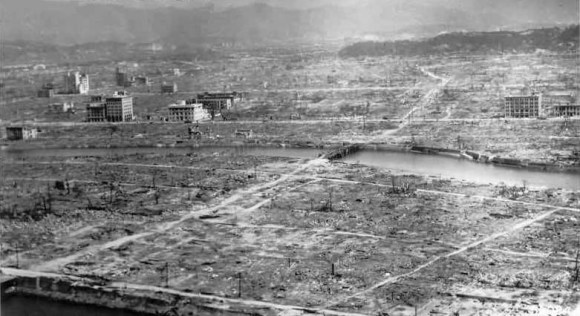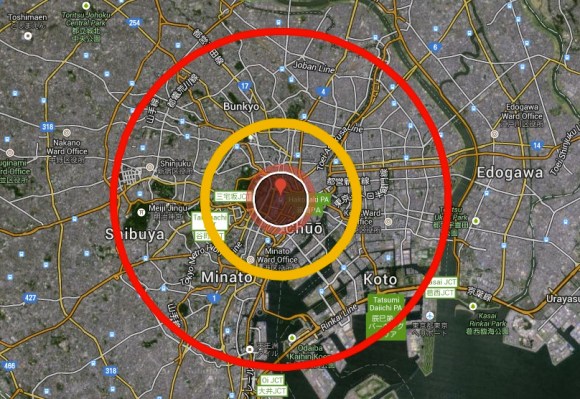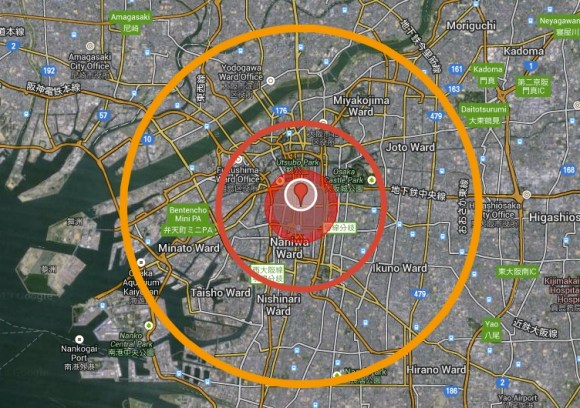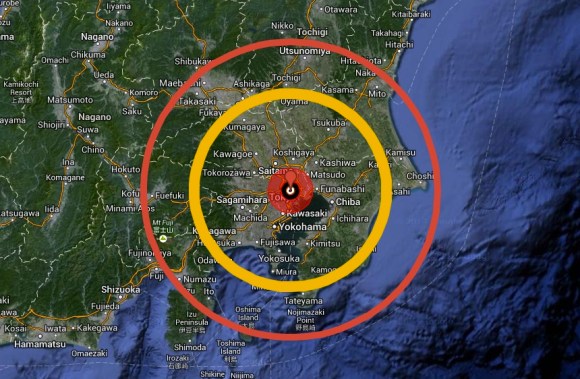
On Wednesday of last week, the city of Hiroshima marked the 69th anniversary of the atomic bombing. When the bomb detonated in the air above Hiroshima on August 6, 1945, it destroyed the city and killed up to 140,000 people. Almost everything in a one-mile radius of the target site was immediately razed to the ground. On August 9, a second bomb was dropped on Nagasaki, killing a further estimated 70,000.
Hiroshima was chosen as the primary target for a number of reasons. The US wanted a target city with an urban area of at least three miles diameter. It also had to have been untouched by other air raids, so that the weapon’s impact could be accurately observed. Hiroshima was also thought to be the only potential target city that did not have any Allied prisoner-of-war camps.
But what if the A-bomb had been detonated over Tokyo instead? Or Osaka? Using statistics collated by Dr. Mark A. Carlson at the University of Nebraska, the Japanese Huffington Post has produced this interactive Google map answering just that question.
Japanese officials have estimated that 69 percent of Hiroshima’s buildings were destroyed in the bombing and fires that followed it. This first map shows how Tokyo – of course, a much bigger city – would have been affected by the blast, had it been the primary target instead of Hiroshima.
If the A-bomb had been dropped over Tokyo central station:
- The area from Kanda in the north to Higashi-Ginza in the south would have been completely destroyed (the shaded black area on the map).
- Around that black area is a red shaded circle, which would have faced “severe” direct damage.
- The next ring out (yellow) is an area of 3.5 km in diameter. Circled by Kiba, Yotsuya, Ueno and Hamamatsuchō, this is the area where buildings would have collapsed and caught fire.
- In the outer-most ring (red), an area 7 km across, windows would have been shattered by the impact. This stretches as far as Shinagawa, Shinjuku, Minamisenju, and Higashi-ōjima.
A second map shows a projection of the damage, had the Abomb been dropped over Osaka, in the central area including Namba and Shinsaibashi:
The makers of these two interactive maps have also made a separate set of projections using the data from Tsar Bomba, the AN602 hydrogen bomb which was detonated in 1961.
The Soviet test of Tsar Bomba, the most powerful man-made explosion in human history, produced around 1,500 times the combined power of the bombs that destroyed Hiroshima and Nagasaki. If it had been dropped on Tokyo, the range of the impact would have been enormous, reaching to Mt. Fuji:
This map shows the projection over Osaka, where the impact would have reached right across the Kansai region:
You can check out the interactive maps of for yourself (Tokyo or Osaka): on the left hand panel, the top check box (水爆「ツァーリ・ボンバ」) shows the projections for Tsar Bomba, while the second (広島型原爆) shows the Hiroshima bomb.
What does it mean to produce images like this, that use kilometres and place names as a way of looking at historical events? Much of the work done by the Hiroshima Peace Memorial Museum has focused on human stories as a means to understanding the impact of the Hiroshima and Nagasaki bombings. Rather than relying on statistics, the museum’s (occasionally controversial) impactful displays include belongings, photos and first-hand accounts of the horror and pain experienced by real people.
There was never any suggestion of an A-bomb being dropped on Tokyo, so this isn’t a historical “what-if”. But by transplanting the bombings to another location, these maps make it more understandable to people from that place. It provides something of a visual key to understanding the scale of events – for those familiar with the Tokyo or Kansai regions, anyway – and a reminder of the enormous scale of the suffering inflicted by the bombing, as we look back 69 years later.
Sources: Huffington Post JP, Hiroshima City Virtual Museum
Top image: U.S. Navy Public Affairs/Wikipedia
Images: Google Maps (1, 2)





 Chilling footage shows Hiroshima eight months after the atomic bombing【Video】
Chilling footage shows Hiroshima eight months after the atomic bombing【Video】 Do Japanese people hate Americans? Hiroshima teen has touching answer on atomic bomb anniversary
Do Japanese people hate Americans? Hiroshima teen has touching answer on atomic bomb anniversary Hiroshima requests removal of Pokémon GO facilities from Peace Memorial Park
Hiroshima requests removal of Pokémon GO facilities from Peace Memorial Park Critically acclaimed A-bomb manga Barefoot Gen excerpts removed from Hiroshima school curriculum
Critically acclaimed A-bomb manga Barefoot Gen excerpts removed from Hiroshima school curriculum Korean pop star wears T-shirt commemorating Hiroshima atomic bombing, draws criticism in Japan
Korean pop star wears T-shirt commemorating Hiroshima atomic bombing, draws criticism in Japan Japan’s EF English Proficiency Index rank drops for 11th straight year, hits lowest ever
Japan’s EF English Proficiency Index rank drops for 11th straight year, hits lowest ever Major Japanese noodle chain is closing on Christmas Eve so workers can spend time with families
Major Japanese noodle chain is closing on Christmas Eve so workers can spend time with families Japan’s human washing machines will go on sale to general public, demos to be held in Tokyo
Japan’s human washing machines will go on sale to general public, demos to be held in Tokyo Nintendo’s Kirby now delivering orders at Kura Sushi restaurants, but not in Japan
Nintendo’s Kirby now delivering orders at Kura Sushi restaurants, but not in Japan Miffy Cafe in Shibuya looks so deliciously cute we could eat it right up 【Pics】
Miffy Cafe in Shibuya looks so deliciously cute we could eat it right up 【Pics】 The top 5 ice creams you should try at Family Mart convenience stores in Japan this summer
The top 5 ice creams you should try at Family Mart convenience stores in Japan this summer Tokyo city hall gets menacing red makeover as coronavirus infection numbers rise【Photos】
Tokyo city hall gets menacing red makeover as coronavirus infection numbers rise【Photos】 Daiso has giant new branch in middle of Tokyo’s Shinjuku neighborhood (and another beneath it)
Daiso has giant new branch in middle of Tokyo’s Shinjuku neighborhood (and another beneath it) Reports that using -chan in Japan constitutes sexual harassment are at least a little exaggerated
Reports that using -chan in Japan constitutes sexual harassment are at least a little exaggerated New Kyoto experience package lets you film epic samurai battles with your friends
New Kyoto experience package lets you film epic samurai battles with your friends Japanese train company is letting fans buy its actual ticket gates for their homes
Japanese train company is letting fans buy its actual ticket gates for their homes Yoshinoya adds first-ever chain-wide ramen with new beef and pork-broth noodle hot pot meals
Yoshinoya adds first-ever chain-wide ramen with new beef and pork-broth noodle hot pot meals Is China’s don’t-go-to-Japan warning affecting tourist crowds in Shibuya’s Don Quijote?
Is China’s don’t-go-to-Japan warning affecting tourist crowds in Shibuya’s Don Quijote? Japan considering raising international traveler departure tax even more than previously reported
Japan considering raising international traveler departure tax even more than previously reported Is China’s don’t-go-to-Japan warning affecting tourist crowd sizes in Nara?
Is China’s don’t-go-to-Japan warning affecting tourist crowd sizes in Nara? Studio Ghibli stamps lift your spirits with motivational phrases from Totoro
Studio Ghibli stamps lift your spirits with motivational phrases from Totoro New fish discovered and named “Vanderhorstia supersaiyan” for obvious reasons
New fish discovered and named “Vanderhorstia supersaiyan” for obvious reasons Japanese town suing resident for being a jerk
Japanese town suing resident for being a jerk Starbucks Japan unveils new Christmas goods and a rhinestone tumbler that costs 19,500 yen
Starbucks Japan unveils new Christmas goods and a rhinestone tumbler that costs 19,500 yen Real-world Nausicaa Ghibli anime glider completes its final flight in Japan【Video】
Real-world Nausicaa Ghibli anime glider completes its final flight in Japan【Video】 Brand-new Pokémon park opens in Japan with larger-than-life-size Lapras【Photos】
Brand-new Pokémon park opens in Japan with larger-than-life-size Lapras【Photos】 Unique inclined elevator in Japan leads to a town that inspired Studio Ghibli’s Spirited Away
Unique inclined elevator in Japan leads to a town that inspired Studio Ghibli’s Spirited Away Is China’s don’t-go-to-Japan warning affecting tourist crowds in Tokyo’s Asakusa neighborhood?
Is China’s don’t-go-to-Japan warning affecting tourist crowds in Tokyo’s Asakusa neighborhood? The 10 best day trips from downtown Tokyo【Survey】
The 10 best day trips from downtown Tokyo【Survey】 Naturally brown-haired Osaka student sues government for forcing her to dye her hair black
Naturally brown-haired Osaka student sues government for forcing her to dye her hair black Tokyo hotel lets you make your stay a Sanrio one with special My Melody and Kuromi rooms【Pics】
Tokyo hotel lets you make your stay a Sanrio one with special My Melody and Kuromi rooms【Pics】 Survey asks foreign tourists what bothered them in Japan, more than half gave same answer
Survey asks foreign tourists what bothered them in Japan, more than half gave same answer Japan’s deadliest food claims more victims, but why do people keep eating it for New Year’s?
Japan’s deadliest food claims more victims, but why do people keep eating it for New Year’s? We deeply regret going into this tunnel on our walk in the mountains of Japan
We deeply regret going into this tunnel on our walk in the mountains of Japan Studio Ghibli releases Kodama forest spirits from Princess Mononoke to light up your home
Studio Ghibli releases Kodama forest spirits from Princess Mononoke to light up your home Major Japanese hotel chain says reservations via overseas booking sites may not be valid
Major Japanese hotel chain says reservations via overseas booking sites may not be valid Put sesame oil in your coffee? Japanese maker says it’s the best way to start your day【Taste test】
Put sesame oil in your coffee? Japanese maker says it’s the best way to start your day【Taste test】 The top 10 annoying foreign tourist behaviors on trains, as chosen by Japanese people【Survey】
The top 10 annoying foreign tourist behaviors on trains, as chosen by Japanese people【Survey】 No more using real katana for tourism activities, Japan’s National Police Agency says
No more using real katana for tourism activities, Japan’s National Police Agency says J-pop mega star Ado reveals she’s been living in the U.S., may not understand language acquisition
J-pop mega star Ado reveals she’s been living in the U.S., may not understand language acquisition Reading Barefoot Gen, manga about the Hiroshima atomic bombing, for the first time as an adult
Reading Barefoot Gen, manga about the Hiroshima atomic bombing, for the first time as an adult Why doesn’t Japan hate America for dropping the A-bombs?
Why doesn’t Japan hate America for dropping the A-bombs? Police looking for man who threw paper airplane into Hiroshima atomic bomb monument
Police looking for man who threw paper airplane into Hiroshima atomic bomb monument Hiroshima residents find unexploded WWII bomb while cleaning out closet
Hiroshima residents find unexploded WWII bomb while cleaning out closet Hang a Japanese city on your wall with these amazingly detailed 3-D printed maps
Hang a Japanese city on your wall with these amazingly detailed 3-D printed maps
Leave a Reply